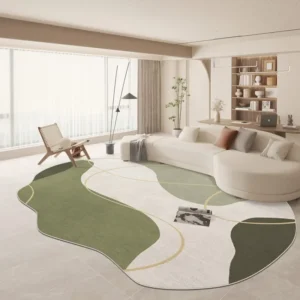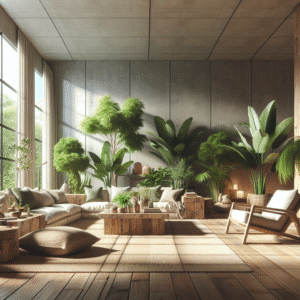Striking Harmony: Mastering the Art of Blending Industrial and Soft Décor for a Balanced Aesthetic
Introduction
In the vast realm of interior design, two contrasting styles often emerge: the robust, raw charm of industrial décor and the gentle, inviting allure of soft décor. Each style possesses its unique characteristics, but when harmoniously blended, they create a rich and balanced aesthetic. Feeling torn between these styles? You’re not alone. Many homeowners grapple with the challenge of merging these seemingly opposing elements into a cohesive space. In this article, we’ll explore how to masterfully combine industrial and soft décor to achieve a sanctuary that reflects both strength and comfort.
By the end of this guide, you will learn actionable strategies for striking the perfect balance between rugged and delicate, insight into design elements that work well together, and tips to personalize your space to reflect your unique taste. Ready to dive in? Let’s explore the fascinating world of blended décor!
The Elements of Industrial and Soft Décor
Understanding Industrial Décor
Industrial décor is characterized by its use of raw materials and a minimalist aesthetic. Common features include:
- Exposed Structures: Visible beams, pipes, and brick walls.
- Repurposed Materials: Items like reclaimed wood and metal fixtures.
- Neutral Color Palettes: Shades of gray, brown, black, and white predominating.
- Functional Furniture: Often features pieces designed for utility over aesthetics, such as metal chairs and wooden tables.
Embracing Soft Décor
On the other hand, soft décor leans into comfort and warmth. Key characteristics include:
- Textiles and Fabrics: Soft cushions, throws, and curtains that invite touch.
- Natural Elements: Use of plants, wood, and stone to create a grounded feeling.
- Warm Color Palettes: Earthy tones, pastels, and deep jewel hues that evoke tranquility.
- Emotional Touches: Personal artworks, family photos, and other sentimental items adding personality.
Finding Your Aesthetic Balance
To successfully blend industrial and soft décor, a strategic approach is essential. Let’s break it down into actionable steps.
Step 1: Identify Your Focal Points
Begin by selecting areas where both styles can shine:
- Living Room: Consider a large, industrial coffee table paired with plush sofas.
- Bedroom: An industrial bed frame with soft linens creates a cozy retreat.
- Kitchen: Stainless steel appliances with wooden shelving.
Step 2: Color Coordination
Choose a color scheme that allows both styles to coexist:
- Base Neutrals: Start with a neutral foundation—think gray or white walls.
- Accent Colors: Introduce soft hues through textiles and décor elements, providing warmth against the starkness of industrial features.
Practical Implementation Strategies
Choosing Furniture Wisely
When selecting furniture, aim for pieces that bridge the gap between industrial and soft styles. Consider:
- Mixed Material Furniture: Items combining wood with metal elements, like a wood dining table with metal legs.
- Versatile Accessories: Decorative elements, such as a metal light fixture paired with a soft fabric lampshade.
Textural Play
Balance hard and soft textures through purposeful layering:
- Layering Fabrics: Use plush cushions and throws on leather or metal sofas.
- Grounding Elements: Incorporate rugs that soften hard flooring, adding warmth underfoot.
Visual Balance in Layout
Creating a visual balance is key to achieving harmony in your space. Here’s how:
- Sympathetic Layout: Align your furniture and décor in a way that feels balanced—don’t cluster all industrial pieces together.
- Balanced Grouping: Mix displays to maintain interest and ensure both styles are represented.
Case Studies in Blended Aesthetics
An exemplary case of industrial and soft décor blending can be seen in modern lofts:
- Loft Spaces: Often embody industrial designs, with high ceilings and exposed bricks, but soften them with cozy seating arrangements and warm lighting.
Tool Recommendations for Design
To assist with your blended décor vision, consider using design software or apps:
- Home Design 3D: Enables you to visualize layouts and styles in 3D.
- Pinterest: For inspiration boards that combine various styles you love.
FAQ Section
What are some key colors to use in industrial and soft décor?
Using gray, white, and black as neutrals for industrial elements, with pops of pastels and earthy tones in soft décor can create balance.
Can I mix metal and wood in my décor?
Absolutely! Metal and wood can beautifully complement each other when styled thoughtfully.
What type of lighting works best?
Utilize industrial pendant lights paired with softer lamps for areas where you want ambiances, such as living rooms and bedrooms.
How can I ensure my space doesn’t feel too cold?
Incorporate warm textiles, personal items, and greenery to soften industrial features.
Is it possible to go overboard with one style?
Yes, balance is key. Avoid clustering too many industrial features together without soft accents.
Conclusion & Next Steps
Successfully blending industrial and soft décor can create a remarkably harmonious and inviting atmosphere. Remember, the key lies in balancing raw, rugged materials with warm, inviting components. Use the strategies outlined in this article to embark on your design journey confidently.
Ready to put these ideas into action? Start by selecting just one area in your home and applying what you’ve learned. As you develop your unique style, consider reading more about color psychology and textiles to deepen your understanding.
Content Disclaimer
The information provided in this article is for educational purposes only and should not be considered professional advice. Always consult with design or architectural professionals for specific projects.
Categories
- Accent Walls & Ceilings (18)
- Art Curation & Gallery (32)
- Bedding Style Trends (43)
- Bedroom Makeover (37)
- Bohemian & Eclectic Styles (18)
- DIY & Budget-Friendly Decor (17)
- Eco-Friendly Design (18)
- Furniture Care (36)
- Home Decor & Design Ideas (108)
- Home Wellness Spaces (18)
- Integrated Outdoor Living (17)
- Kids and Nursery Decor (18)
- Living Room Decor (37)
- Minimalist & Japandi Style (20)
- Mix & Match Techniques (36)
- Modern & Contemporary Design (17)
- Rug Sizing & Placement (36)
- Seasonal Home Decor (39)
- Small Space Solutions (21)
- Wall Art & Painting Tips (39)
Recent Comments
Archives
Product Gallery
-
 Large Area Green Rugs for Bedroom Nordic Living Room Decoration Shaped Carpet Irregular Plush Lounge Rug Home Thick Washable Mat Rated 5.00 out of 5$56.95 – $359.13Price range: $56.95 through $359.13
Large Area Green Rugs for Bedroom Nordic Living Room Decoration Shaped Carpet Irregular Plush Lounge Rug Home Thick Washable Mat Rated 5.00 out of 5$56.95 – $359.13Price range: $56.95 through $359.13 -
 Nordic Style Rugs for Bedroom Morandi Living Room Decoration Carpet Large Area Geometry Lounge Rug Home Cloakroom Non-slip Mat Rated 5.00 out of 5$40.93 – $620.00Price range: $40.93 through $620.00
Nordic Style Rugs for Bedroom Morandi Living Room Decoration Carpet Large Area Geometry Lounge Rug Home Cloakroom Non-slip Mat Rated 5.00 out of 5$40.93 – $620.00Price range: $40.93 through $620.00 -
 Irregular Shapes Living Room Decoration Carpet Modern Style Rugs for Bedroom Home Thicken Plush Rug Fluffy Soft Lounge Floor Mat Rated 4.75 out of 5$57.89 – $360.12Price range: $57.89 through $360.12
Irregular Shapes Living Room Decoration Carpet Modern Style Rugs for Bedroom Home Thicken Plush Rug Fluffy Soft Lounge Floor Mat Rated 4.75 out of 5$57.89 – $360.12Price range: $57.89 through $360.12














